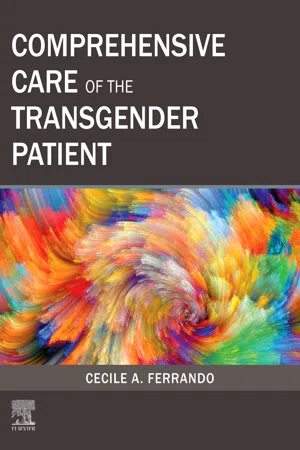Introduction
Transsexual, transgender, and gender nonconforming individuals have been a part of all cultures historically, yet the emergence of, and advocacy for, transgender individuals in the Western world have become prominent only in recent decades.
The majority of clinical experience related to transgender care is derived from higher-income settings. Therefore local adaptation of clinical care protocols is required, in view of varying cultures and social norms across low- and middle-income countries. Gender roles are culturally stereotyped in most societies where men and women are supposed to participate in masculine and feminine roles specific to their assigned sex at birth.1
Deviation from normative gender roles often results in devaluation of social status and experiences of stigma.2,3 Although transgender people exist across cultures throughout the world, transgenderism and transsexualism are considered abnormal in most societies, because they transgress the normative sex-gender binary system.4–6 Perceptions of transgender people are affected by the profound differences in culture, religion, and history that exist between countries, and presentation and acceptance of gender diversity can vary widely even within regions of the world. For example, the variation in acceptance of gender diversity across Asia is independent of religion, economic level, and even subregion, with some countries having broader acceptance (such as Thailand, Laos, and Indonesia) and other countries (including Malaysia) having less acceptance.7–12 Although many transgender people struggle to establish a separate gender category beyond the male-female binary system, only a few countries have acknowledged transgender as a “third” gender. In December of 2007, the Supreme Court of Nepal issued a groundbreaking verdict in favor of gender minorities and recognition of a third gender. In November 2013, two remarkable developments took place in the gender debate and legal and human rights framework: Germany became the first European country to officially recognize a third gender for babies born with ambiguous genitalia, through a new legislation by the country’s constitutional court13; and the Government of Bangladesh officially approved a proposal by the social welfare ministry to identify transgender women (also known as hijra) within a separate gender category.14 In April 2014, India’s Supreme Court recognized transgender people as members of a third gender in a landmark ruling.15 In 2015, the Nepalese authorities decided to issue passports to gender minorities, adding a third gender category.16
Although transgender people across cultures are known by various indigenous terms, the increased visibility in many settings of transgender women, compared with transgender men, has resulted in increased social awareness of these women. Transgender women across many settings share some commonalities, such as preferences for feminine attire and body gestures, a sense of community, and, because of their gender incongruence, a status that has traditionally not been socioculturally, religiously, politically, and legally acknowledged. Because of such pervasive nonacceptance, many transgender women seek social or medical transition.1,17 Nevertheless, scientific information about transition-related issues is scarce. Access to transition-related health services is often limited, especially in many low- and middle-income countries. Many transgender women seek clinical or surgical procedures, or both, by taking hormones, removal of genitals, or other gender-affirming surgery.18–20 For example, hijras in south Asian countries often seek social and psychological fulfillment by partial or complete removal of the male genital organs (castration) by modern or traditional caregivers, and some even seek modern gender affirmation surgery that is unavailable in their home countries.21,22 The limited numbers of clinically skilled providers and high costs of medical interventions in most Asian countries have encouraged access to providers who are unskilled in performing medical interventions, causing untoward physical and psychological effects.23
Castration for transgender women involves removal of the penis and scrotum without the construction of female genitals. The underlying reasons for seeking castration and gender affirming surgery can go further than relief from physical dysphoria and perceived needs for compatible and socially acceptable sex-gender aligned lifestyles. The meaning of castration can vary—for example, for some hijra, it represents sociocultural restructuring through which they ensure their economic survival by their engagement with the hijra community.23 Members of this community can earn their living through traditional hijra occupations (known as badhai), such as collecting money from the market places (bazar tola) and blessing newborn babies (bachcha nachano).24 Castration can also enhance their self-esteem, power, and status within and outside of the hijra community; through castration they become “real” hijras21,23 who can earn more than noncastrated hijras through badhai and by selling sex.
Not all transgender women go through castration or gender-affirming surgery. Instead, many adopt feminine gestures, clothing, voices, and roles. This type of sociocultural adaptation enables the individual to have the experience of being transgender without any medical or surgical intervention. Those who have undergone castration often report substantial physical side effects, such as urethral strictures, severe infections, and loss of libido.23,25–27 Moreover, social and legal dilemmas exist. For example, some noncastrated hijra believe that medical intervention may reemphasize the dominant binary gender construction that ignores transgender as a separate gender. This is seen as a violation of their basic rights to life and survival.
People whose gender identity does not align with a rigid male/female dichotomy have been ostracized, leading to pervasive stigma and discrimination in all areas of life for transgender people. Normative notions often marginalize transgender people and place them in an abusive sociolegal environment, in which they are sociopolitically, religiously, and economically excluded from the mainstream, which in turn may enhance their risk-taking behaviors.3 Pathologization of gender and sexual minorities in the Western medical model28 has often resulted in transgender people being labeled as deviant individuals requiring medical and legal attention. As cross-cultural diversity and fluidity of gender and sexuality have received attention, it is expected that standard care and services for transgender people will become available in most countries within the framework of human rights.
...